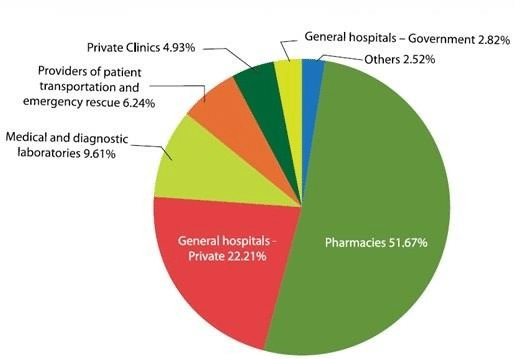Ahmedabad
(Head Office)Address : 506, 3rd EYE THREE (III), Opp. Induben Khakhrawala, Girish Cold Drink Cross Road, CG Road, Navrangpura, Ahmedabad, 380009.
Mobile : 8469231587 / 9586028957
Telephone : 079-40098991
E-mail: dics.upsc@gmail.com

Out of Pocket Expenditure on Health
News: The National Health Accounts (NHA) report for 2017-18 is being celebrated widely as it shows that total public spending on health as a percentage of GDP has increased to a historic high of 1.35% of GDP.
Background:
• India’s total public spending on health as a percentage of GDP or in per capita terms has been one of the lowest in the world.The Union government traditionally spends around a third of the total government spending whereas the majority is borne by the States.
• There has been a policy consensus for more than a decade now that public spending has to increase to at least 2.5% of GDP.However, there has not been any significant increase so far. Despite several pronouncements, it has continued to hover around 1%-1.2% of GDP.
Significance of NHA Report:
• The National Health Accounts (NHA) report capture spending on health by various sources, and track the schemes through which these funds are channelised to various providers in a given time period for a given geography.
• The National Health Accounts (NHA) report for 2017-18 is being celebrated widely as it shows that total public spending on health as a percentage of GDP has increased to a historic high of 1.35% of GDP.
• The increase shown in NHA 2017-18 is largely due to increase in Union government expenditure.Increase in Centre’s share: For 2017-18, the Centre’s share in total public spending on health has jumped to 40.8%.
• However, if we study the spending pattern of the Ministry of Health and Family Welfare and the Ministry of AYUSH, we see that expenditure increased to 0.32% of GDP from 0.27% in 2016-17 — insufficient to explain the overall jump.
Issues:
• Much of this increase has actually happened on account of a tripling of expenditure of the Defence Medical Services (DMS).Compared to an expenditure of ₹10,485 in 2016-17, it increased to ₹32,118 crore.
• Though the increasing spending for the health of defence personnel is a good thing, such spending does not benefit the general population. Within government expenditure, the share of current health expenditure has come down to 71.9% compared to 77.9% a year ago.
• This essentially means, capital expenditure has increased, and specifically in defence.There is a problem in accounting capital expenditure within the NHA framework.
• Equipment brought or a hospital that is built serves people for many years, so the expenditure incurred is used for the lifetime of the capital created and use does not get limited to that particular year in which expenditure is incurred.
• The World Health Organization proposes to leave out capital expenditure from health accounts estimates, instead focus on current health expenditure.
• In NHA estimates in India, in order to show higher public investment, capital expenditure is included; thus, Indian estimates become incomparable to other countries.The NHA estimate also shows that out-ofpocket expenditure as a share of GDP has reduced to less than half of the total health expenditure.
• NSSO 2017-18 data suggest that during this time period, utilisation of hospitalisation care has declined compared to 2014 NSSO estimates for almost all States and for various sections of society.
• The decline in out-of-pocket expenditure is essentially due to a decline in utilisation of care rather than greater financial protection.Actually, the NSSO survey happened just after six months of demonetisation and almost at the same time when the Goods and Services Tax was introduced.
• The disastrous consequences of the dual blow of demonetisation and GST on the purchasing power of people are quite well documented.
• Another plausible explanation is linked to limitations in NSSO estimates. The NSSO fails to capture the spending pattern of the richest 5% of the population (who incur a large part of the health expenditure).
• Thus, out-of-pocket expenditure measured from the NSSO could be an under-estimate as it fails to take into account the expenditure of the richest sections.
• The reduction of out-of-pocket expenditure is a sign of distress and a result of methodological limitations of the NSSO, rather than a sign of increased financial protection.

Address : 506, 3rd EYE THREE (III), Opp. Induben Khakhrawala, Girish Cold Drink Cross Road, CG Road, Navrangpura, Ahmedabad, 380009.
Mobile : 8469231587 / 9586028957
Telephone : 079-40098991
E-mail: dics.upsc@gmail.com
Address: A-306, The Landmark, Urjanagar-1, Opp. Spicy Street, Kudasan – Por Road, Kudasan, Gandhinagar – 382421
Mobile : 9723832444 / 9723932444
E-mail: dics.gnagar@gmail.com
Address: 2nd Floor, 9 Shivali Society, L&T Circle, opp. Ratri Bazar, Karelibaugh, Vadodara, 390018
Mobile : 9725692037 / 9725692054
E-mail: dics.vadodara@gmail.com
Address: 403, Raj Victoria, Opp. Pal Walkway, Near Galaxy Circle, Pal, Surat-394510
Mobile : 8401031583 / 8401031587
E-mail: dics.surat@gmail.com
Address: 303,305 K 158 Complex Above Magson, Sindhubhavan Road Ahmedabad-380059
Mobile : 9974751177 / 8469231587
E-mail: dicssbr@gmail.com
Address: 57/17, 2nd Floor, Old Rajinder Nagar Market, Bada Bazaar Marg, Delhi-60
Mobile : 9104830862 / 9104830865
E-mail: dics.newdelhi@gmail.com